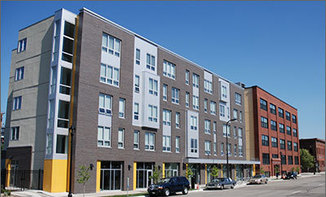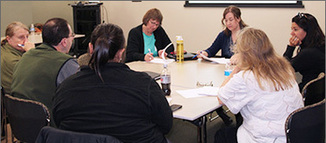|
In 2015, Hennepin Health has worked to strengthen its relationships with chemical dependency and mental health treatment facilities like Park Avenue Center, RS Eden, NuWay, and Anchor House. Some of these facilities are now, with member permission, sending Hennepin Health the names of people who are in the facilities, and due to transition out. After receiving these referrals, Hennepin Health’s social service navigators reach out to the members in advance of their transition.

RS Eden
DeAnna Hayden, a Hennepin Health social service navigator, explains the goal: “If we can catch people before they’re actually discharged we can try to meet some of their social service needs so that when they get discharged they don’t end up, say, back in the shelter — or get out and don’t have anything lined up in terms of follow-up care.”
Hennepin Health social service navigators connected to Lafonso Rollins, who is profiled below, via this improved transition process.
Back to top
This is a part one of a two-part series about Hennepin Health member Lafonso Rollins, who has been working with Hennepin Health since early 2015.
Part 1: Childhood and Prison
In 1994, 19-year-old Lafonso Rollins was sentenced to 75 years in prison for a crime he didn’t commit and was later exonerated for: the rape of a 78-year-old woman. Rollins spent 10 years in prison for the crime, and is still riddled with anxiety from those years behind bars. Yet, today, at 39, at his studio apartment in Elliot Park, Rollins is adamant that prison was not his lowest point.
“The worst thing that ever happened to me was getting taken away from my mother [and placed in foster care],” Rollins said.
Looking pained, Rollins describes the trauma he suffered in foster care, including a “white dude who beat me until I learned my ABC’s.” At age 14, Rollins dropped out of ninth grade, ran away from foster care, and returned to his mother, Dorothy Gurley.
Rollins recalls the moment that mother and son were reunited. It was “raining and dark” the day that Rollins went to the corner of East 63rd Street and South University Avenue — an area which, according to Rollins, was called “the hoe stroll” — to find his mother. A person told him that she was staying at an apartment at 6450 South Kenwood Avenue.
When Rollins arrived at the apartment, he was greeted by his mother’s boyfriend. His mother arrived later. At first, Gurley didn’t recognize her son and mistook Rollins for his sister.
“Mom, it’s me,” Rollins told her.
“Hi Big Jim,” Gurley said, then, addressing Rollins by his nickname. “I’m so glad you’re back.”
Despite those less-than-ideal circumstances, “I look at this [moment] like a palace,” Rollins said.
But the time that the two had together was fleeting. In October 1992, a few months before Rollins’ wrongful arrest, Gurley, then 37, was stabbed to death by her boyfriend. Rollins said that, for years afterward, “a goal of mine was to pass my mother’s age.”
***
In 1993, Rollins was arrested on the grounds of Kenneth Campbell Apartments, a Chicago Housing Authority complex, where police were investigating a series of robberies and rapes against elderly residents. Two of the victims had given descriptions of their attacker to an artist, who created a composite sketch. The building manager believed the sketch resembled Rollins, who regularly visited a resident who lived on the eighth floor.
Rollins was taken in for questioning and held for 13 hours at the Chicago Police Department. While there, he confessed in writing to the attack. Rollins immediately retracted the confession and claimed that he was innocent, explaining that he had only “confessed” in order to stop being struck and threatened by the detectives who were questioning him. Nonetheless, the written confession was used as a key piece of evidence in his trial.
Although the Chicago Police Department had collected a sample of the assailant’s semen — found on a pillowcase in the victim’s apartment — as well as samples of Rollins’ blood and saliva, and submitted them to a Chicago crime lab, Rollins’ lawyer failed to obtain the results. Serology testing had excluded Rollins, but the results were not disclosed to the defense.
On March 4, 1994, Rollins was tried as an adult and sentenced to 75 years in prison.
***
While in prison, Rollins read the duPont REGISTRY fastidiously. Perusing the magazine’s luxury property listings — and imagining the alternate lives that they represented — was “how I got by,” he said.
Then Rollins heard about The Innocence Project. The New York-based organization is dedicated to exonerating wrongfully convicted individuals through DNA testing and to reforming the criminal justice system. According to the organization’s website, 3,000 people write to the Innocence Project each year asking for help. And at any given time, the staff are evaluating 6,000 to 8,000 potential cases.
Rollins first letter to The Innocence Project was denied.
Afterward, a fellow inmate nicknamed “Bull” helped Rollins draft a post-conviction relief petition and a motion for DNA testing in exchange for a mixtape. A week later, Bull died in his sleep.
Ultimately the Innocence Project agreed to help Rollins, and he was assigned a public defender named Ingrid Gill.
On June 22, 2004, Rollins and Gill finally obtained DNA test results. The results excluded Rollins as the perpetrator of the sexual assault. He was released from prison in July 2004 — 4,193 days after he was wrongly imprisoned.
Unfortunately, Rollins had no one to greet him on the day he got out. Virtually all of his relatives had died shortly before — or while — he was in prison. His older sister, Bertha Gurley, had been robbed, shot, and killed in August 1993, a few minutes after leaving an ATM on Chicago’s South Side with fifty dollars. His grandmother and father had died in 2004, months before his release.
***
Today Rollins lives in Minneapolis' Elliot Park neighborhood. The June 2015 newsletter will detail Rollins’ life after prison, including his work with Hennepin Health.

Rollins works with DeAnna (right), a Hennepin Health social service navigator
Back to top
Group Residential Housing (GRH) is a state-funded income supplement that pays for an individual’s room and board expenses in licensed or registered settings. Nearly 20,000 people in Minnesota receive GRH each month.
People eligible for GRH include adults age 65 or older — or adults 18 or older with a certified disability or a disabling condition — who have low income and assets.
GRH and Employment
People can work while they’re on GRH — in fact, it’s encouraged! Some points to consider:
-
People who work while they’re on GRH will have more money at the end of the month. See how by going to Minnesota Disability Benefits 101 (DB101) website (http://mn.db101.org/) and clicking on the Benefits and Work Estimator.
- People who work while they’re on GRH can save money and be able to move off of GRH if they want. Moving off of GRH gives people more options for where they can live.
-
Learn how rewarding work can be. Call the Disability Linkage Line at 1-866-333-2466 to: understand how working impacts a person’s benefits and housing; explore work options and next steps one can take; get help using the DB101 Benefits and Work Estimator.
- Remember that going to work does not necessarily mean that one loses GRH. If a housing provider tells a person that they’ll lose their housing if they go to work, call 651-431-3845 to report it.
Upcoming Changes
Starting October 1, 2015, people who work and receive GRH, General Assistance (GA), or Minnesota Family Investment Program (MFIP) benefits will be able to keep more of their monthly earnings. Today, people on GRH pay all of their income to the GRH provider and keep only $97 of spending money each month. After this change, people will keep the first $65 of their work earnings, and half of the rest.
Starting June 1, 2016, people who receive GRH, GA, or MFIP will be able to save more of their income. Today, people on GRH cannot have more than $1,000 or $2,000 in assets, and the rules about what counts as an asset are complicated. After this change, people will be able to save up to $10,000 in assets. Things that will be counted as assets include bank accounts, cash, certain vehicles, and liquid stocks and bonds.
Note: The asset limit for GRH recipients on Supplemental Security Income (SSI) or Social Security Disability Insurance (SSDI) will remain $2,000 (the limit set by the Social Security Administration).
For more information on GRH reform, subscribe to the GRH and MSA Updates mailing list. On this page, you’ll also find past mailings. The December 2014 mailing explains the original GRH reform proposal.
GRH Training
If you’re interested in GRH training for your clinic or program, contact:
Kristine Davis
GRH Specialist
Kristine.Davis@state.mn.us
651-431-3845
Back to top

Domain #3: Nurturing a Trauma Informed and Responsive Workforce Part I — Training Staff about Trauma
In order for an agency or department to move closer to TIC, staff training and development is key. Here are three training components:
1. Understand the impact of trauma.
Review the findings of the Adverse Childhood Experiences (ACE) study; they illustrate the universality of adverse childhood experiences and their impact on medical and behavioral health outcomes. After an introduction to this data, trainees almost always ask, “So now what?” This leads to the next training area: offer practical tips.
2. Offer practical tips that staff can integrate into their work with clients.
Many TIC concepts are interchangeable with concepts of the Recovery and Person-Centered Care models. The goal is to help individuals change the way they see their clients. A shift from “What’s wrong with them?” to “What happened to them?,” “What’s right with them?” and “What are this person’s goals?” all encompass the spirit of TIC, leading staff to view the client through a more compassionate lens.
In medical settings, the power differential between the patient and the provider is huge and it can be a major reason why people who have experienced trauma avoid medical settings or present with anxiety. Taking steps to bridge this gap and to give more control to the patient can make a significant difference. Offering choices about procedures, providing unhurried attention, and anticipating triggers are all TIC practices that providers can incorporate.
The Health Coaching techniques developed by Tom Bodenheimer are very much in line with TIC principles. One technique is called “ask-tell-ask.” Because health professionals are so used to telling their patients what to do, the technique leads with asking the patient what they know, listening, and then providing further explanation or correcting misinformation — followed by asking the patient to explain the information back to the provider.
Here are some additional principles for sensitive practice:
- Taking time to listen and talk
- Rapport building
- Sharing information (mutual exchange)
- Sharing control of the interaction
- Respecting boundaries
- Fosterong mutual learning
- Understanding non-linear healing
- Demonstrating awareness and knowledge of trauma.
3. Include knowledge of the TIC domains and practical examples of action in each domain.
TIC training should include an explanation of each domain and concrete organizational steps that can be taken to become more trauma informed. Small group time at the end of the training should be spent brainstorming further ways the organization can improve in each domain, and corresponding action steps.
Another important aspect of domain #3 is addressing the emotional impact of human services work on human services staff. Next month’s article will focus on the topics of compassion fatigue, secondary trauma, and burnout.
Back to top
|